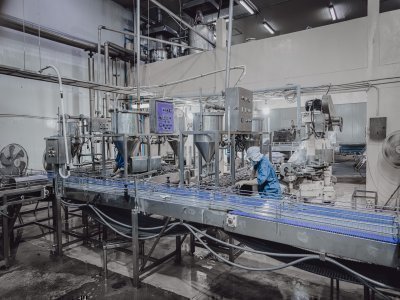Flour Dust Now Has a Legal Limit for the First Time in Australia
From December 2026, new workplace exposure limits (WELs) will apply to flour dust, introducing one of the most significant health and safety changes for food manufacturers in years.
From 1 December 2026, Australia’s Workplace Exposure Limits (WELs) will replace the old Workplace Exposure Standards (WES) under updates announced by Safe Work Australia.
Among the most notable inclusions is a new occupational exposure limit for flour dust, now formally recognised as an airborne contaminant that can cause adverse health effects in food production workers.
Until now, flour dust was only covered under the generic “Particulates Not Otherwise Classified” category, with exposure levels of 3–10 mg/m³.
The new time weighted average (TWA) limit is 0.5 mg/m³ over an eight-hour working day, a tenfold reduction from typical previous benchmarks.
This means many bakeries, mills, and food processing facilities will need to reassess their airborne concentrations and control measures to stay compliant before the December 2026 enforcement date.
The Bigger Picture: WEL Changes Across Multiple Industries
The new flour dust limit is part of a much wider reform. Safe Work Australia’s 2025 review of airborne contaminant standards added 31 new substances and tightened many existing exposure limits.
These changes affect industries far beyond food manufacturing, as allowable airborne contaminant levels are being lowered across mining, manufacturing, transport, agriculture, and construction.
Key changes include:
- Flour and Grain Dusts - new limit of 0.5 mg/m³ (8-hour TWA) for bakeries, mills, and food factories
- Diesel Exhaust - now formally regulated at 0.01 mg/m³ (as respirable elemental carbon), impacting logistics, depots, and councils operating diesel fleets
- Asphalt Fumes and Coal Tar Pitch Volatiles - updated exposure requirements for road construction and asphalting works
- Wood Dust - reaffirmed as a respiratory sensitiser, requiring improved ventilation and extraction in timber, furniture, and joinery workshops
These updates align Australia with international best practice and signal a shift towards tighter controls for both visible and invisible airborne contaminants.
By December 2026, all affected industries will need to demonstrate compliance through validated monitoring, documentation, and control verification.
Which industries will feel it the most — and which ones might be caught by surprise?
Discover the full breakdown of affected sectors in JTA’s companion article:
Industries Most Affected by Australia’s 2026 Workplace Exposure Limits →
Why the New Workplace Exposure Limit Matters
Flour dust is far more than a nuisance; it is a biologically active material that can cause respiratory irritation, occupational asthma, and other adverse health effects when inhaled.
Prolonged exposure to hazardous substances such as flour dust has been linked to chronic airway inflammation and allergic reactions in workers across baking, milling, and packaged food sectors.
By setting a defined workplace exposure limit, Safe Work Australia aims to reduce dust exposures and improve the overall health and safety of employees in the food manufacturing industry.
The new standard acknowledges that even minimal airborne concentrations of flour can be harmful over time.
Food businesses will now need to:
- Measure exposure levels through accredited air monitoring
- Identify high-risk processes including mixing, sieving, bagging, and cleaning
- Implement effective control measures such as local exhaust ventilation (LEV) and enclosed systems
- Ensure PPE programs are supported by respirator fit testing
- Validate results through an occupational hygienist or qualified consultant
Industry Already Responding
According to Tom Trotman, Commercial Director at JTA Health, Safety & Noise Specialists, food manufacturers are moving quickly to understand the implications.
“Since the WEL announcement, we have had a flurry of calls from bakeries and food producers wanting to know what this change means for them.
Most did not realise that flour dust never had its own exposure limit before, and that the new threshold is ten times stricter than what they have been working to.
Our Detect. Protect. approach helps them identify where dust exposure is occurring now, and what needs to change before 2026.”
This shift reflects an increasing awareness across the industry that air monitoring and occupational exposure limits are no longer optional; they are critical components of regulatory compliance and worker protection.
Real-World Example: Patties Foods – Setting the Standard for Compliance
Patties Foods has demonstrated that being regulation ready is not about waiting for change, it is about anticipating it.
In August 2025, JTA Health, Safety & Noise Specialists conducted a detailed Flour Dust Exposure Assessment at Patties’ Lucknow, Victoria facility. The assessment confirmed that Patties had already implemented strong workplace hygiene, ventilation, and housekeeping systems, positioning them ahead of the upcoming December 2026 Workplace Exposure Limits (WEL) for flour dust and related particulates.
JTA’s occupational hygienists carried out personal and static air monitoring, real-time dust mapping, and VOC assessments across multiple production lines. Results showed that Patties’ mixing and pastry lines already operated with effective local exhaust ventilation, high-volume dilution airflow, and routine respirator access, supported by robust training and cleaning protocols.
While JTA identified opportunities to further enhance extraction at flour addition points, the overall data reflected a well-controlled and well-managed environment, a facility that understands its regulatory obligations and acts on them early.
The report concluded that Patties Foods’ proactive approach would make future compliance straightforward under the new 0.5 mg/m³ WEL for flour dust.
JTA also verified that no measurable gases or VOCs (carbon monoxide, sulphur dioxide, ammonia, or hydrogen sulphide) were detected anywhere on-site, further demonstrating that the company maintains excellent control of airborne health risks across its operations.
“Patties Foods is a great example of a business that does not wait for regulation to act,” said Jackson Trotman, JTA’s Technical Director.
“They have invested in exposure monitoring, training, and engineering controls to protect their workforce and ensure long-term compliance, well before the new flour dust exposure limits apply.”
By integrating ongoing air monitoring with continuous improvement and a clear hierarchy of control, Patties Foods shows how large-scale food manufacturers can stay ahead of the curve, protecting both people and production integrity.
What Food Manufacturers Should Do Now
1. Conduct Baseline Air Monitoring
Quantify dust exposures in production, packaging, and cleaning areas.
2. Review Engineering Controls
Upgrade extraction systems and implement improved control measures for airborne particulates.
3. Check Respiratory Protection
Perform fit testing and confirm that PPE meets current standards for inhalable dust.
4. Engage an Occupational Hygienist
Review exposure levels, assess airborne concentrations, and document a clear compliance plan.
5. Train and Inform Workers
Communicate the health risks of flour dust and new workplace exposure limits (WELs) through refresher training and toolbox talks.
How JTA Can Help
JTA’s Detect. Protect. framework combines scientific accuracy with practical implementation to ensure compliance and worker safety.
Our specialists provide:
- Air monitoring for flour, grain, diesel, asphalt, and wood dusts
- Occupational exposure limit assessments aligned with WEL requirements
- Noise and ototoxic chemical testing to identify combined risks
- Control measure reviews including LEV, PPE, and procedural recommendations
- Audit-ready documentation that meets Safe Work Australia and insurer expectations
Working with JTA means your workplace gains a clear, data-driven understanding of current conditions and a roadmap for compliance by December 2026.
Stay Ahead of the 2026 Deadline
The introduction of new Workplace Exposure Limits (WELs) marks a step change in Australia’s approach to occupational health.
From food production and transport depots to road construction and timber workshops, every industry handling airborne contaminants will need to demonstrate compliance.
Businesses that act early will protect their people, reduce regulatory risk, and demonstrate leadership in health and safety best practice.
If you have not completed an air monitoring assessment in the last 12 months, now is the time.
Detect hazards. Protect your people. Stay compliant.
Our team is ready for your call! 1300 856 282
Get a Quote/Book Online
OR
Call Us on 1300 856 282
References
1 https://www.pnas.org/content/118/17/e2018995118









